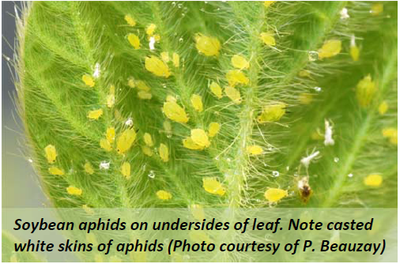This time of year soybean aphids are found on the underside of leaves in the upper trifoliate. Look for the small 1/8th inch light green aphid with two black cornicles (tailpipes) on rear of abdomen.
|
|
In some cases, fields are near or have already reached the economic threshold near Grand Forks and other areas in the Red River Valley. Minnesota also is reporting increasing populations of soybean aphids near threshold in Fergus Falls area (Source: I. MacRae, UMN).
The economic threshold for soybean aphids in the upper Midwest is 250 aphids per plant on 80% of more of the plants, and an increasing aphid population. Most fields are in the late vegetative to R1 (beginning of flowering) growth stages.
The 250-aphids-per-plant threshold is valid from late vegetative through the R5 (early seed development) growth stages. Research indicates that insecticide applications at R6 (full seed) and beyond do not give a positive yield benefit. Therefore, insecticide applications for soybean aphids are not recommended after the R5 growth stage.
Research on the economic threshold for soybean aphid was conducted over a three-year period at 19 locations in the northern U.S., which included North Dakota. The economic threshold was established to give growers a five to seven day lead time for insecticide application before aphid populations reach a level where economic losses actually begin.
Even though soybean market prices are high, the 250 aphids per plant threshold is still valid. This is because 250 aphids per plant are lower than the population at which yield loss can be measured and attributed to aphid injury. What this means, in practical terms, is that the lead time for insecticide application is reduced from seven days to three or four days with higher crop prices. Therefore, it is critical that growers monitor their fields closely.
NDSU Extension Entomology has received a few calls from growers asking whether they should tank mix an insecticide with their last glyphosate application, even though soybean aphid numbers are not at the threshold.
We do not recommend this practice, nor do we recommend any insecticide application when the economic threshold has not been reached. Beside the incompatibilities or phytotoxicity issue with tank-mixing insecticides and herbicides, the optimal application is different for herbicides versus insecticides.
For example, glyphosate herbicide spraying is conducted with low-pressure and large droplet-size nozzles to reduce spray drift. In contrast, insecticides are normally sprayed using high pressure and small droplet-size nozzles.
Applying insecticides too early to control soybean aphids very well may result in a re-invasion of aphids, which would require a second insecticide application. Insecticides also kill natural enemies of soybean aphids, such as lady beetles and damsel bugs, so re-invading aphid populations can increase very rapidly in the absence of natural enemies. Conservation of natural enemies is important in controlling soybean aphids, so don’t spray unless and until you have to.
Some vendors are offering guarantees on second insecticide applications. While the guarantee covers the chemical, it may not cover application costs.
There also is the risk of spider mite flare-ups in fields that have been treated twice with pyrethroid insecticides because beneficial predaceous mites also have been killed and pyrethroids trigger the spider mite’s reproductive ability. This may require a third application using an organophosphate insecticide to control the spider mites.
Pyrethroid and organophosphate insecticides offer good control of soybean aphids. A listing of insecticides registered for soybean aphid control is available from the ND Field Crop Insect Management Guide 2011, E-1143, NDSU Extension Service: http://www.ag.ndsu.edu/pubs/plantsci/pests/e1143w1.htm







Post a comment
Report Abusive Comment